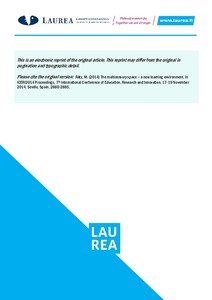The multicensory space : a new learning environment
Räty, Minttu (2014)
Julkaisun pysyvä osoite on
https://urn.fi/URN:NBN:fi:amk-2018103016353
https://urn.fi/URN:NBN:fi:amk-2018103016353
Tiivistelmä
In this paper, I describe the experiences of a pedagogical development project at Laurea University of Applied Sciences in Finland. The project is realized by Laurea in co-operation with various learning institutes, municipalities and NGOs. The aim is to develop new methods for using multisensory learning environments for different target groups. In 2011-2014, the project is funded by The European Social Fund.
The basis of the project is “The Multisensory Space”, which means an easily modified space, where visitors can experience landscape, sounds and objects of a different cultural environment. In the Multisensory Space, a visitor can, for a moment, return to his or her past or explore a completely different world. Multisensory environment is used, for example, for collecting local memories and history, for promoting multiculturalism, and as an inspirational learning environment.
The development of “The Multisensory Space” as a method was started at Laurea with the multicultural work, where the aim is to promote intercultural interaction and the understanding of multicultural issues. Each year since 2008 more than 100 students at Laurea have been involved in the project. According to the students’ feedback, the project has provided new insights concerning intercultural communication and working with the concept of identity negotiation.
For five years, the idea has been applied together with different target groups. Different pilots have shown that the model can be applied to open multisensory learning environments in different contexts, and it can be utilized in the activities of different organizations, such as learning institutions, libraries and museums. It is not only the visitors who benefit from the model and vice versa. Rather, it is more about the empowerment process where people from different backgrounds build and negotiate the environments together.
At the end of my presentation, I shall discuss how you could apply the method in the teaching at the comprehensive school. It does not merely mean the ready-made learning environment but the students could build the different “multisensory environments” in groups as their learning projects.
Building the space together concretizes abstract things, and the method could be used for different subjects, such as teaching languages or history, for the benefit of different learners.
The basis of the project is “The Multisensory Space”, which means an easily modified space, where visitors can experience landscape, sounds and objects of a different cultural environment. In the Multisensory Space, a visitor can, for a moment, return to his or her past or explore a completely different world. Multisensory environment is used, for example, for collecting local memories and history, for promoting multiculturalism, and as an inspirational learning environment.
The development of “The Multisensory Space” as a method was started at Laurea with the multicultural work, where the aim is to promote intercultural interaction and the understanding of multicultural issues. Each year since 2008 more than 100 students at Laurea have been involved in the project. According to the students’ feedback, the project has provided new insights concerning intercultural communication and working with the concept of identity negotiation.
For five years, the idea has been applied together with different target groups. Different pilots have shown that the model can be applied to open multisensory learning environments in different contexts, and it can be utilized in the activities of different organizations, such as learning institutions, libraries and museums. It is not only the visitors who benefit from the model and vice versa. Rather, it is more about the empowerment process where people from different backgrounds build and negotiate the environments together.
At the end of my presentation, I shall discuss how you could apply the method in the teaching at the comprehensive school. It does not merely mean the ready-made learning environment but the students could build the different “multisensory environments” in groups as their learning projects.
Building the space together concretizes abstract things, and the method could be used for different subjects, such as teaching languages or history, for the benefit of different learners.
